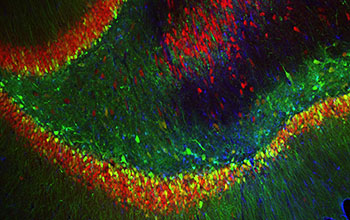Multimedia Gallery
Rat hippocampus with injected virus
This image shows a rat hippocampus, a region of the brain critical for learning, memory and emotion. The green cells show where researchers used an injected virus to block production of a protein called fibroblast growth factor 9 in rat brains and reduce anxiety-like behavior.
More about this image
The persistent feeling of sadness, a loss of interest, or feeling "less than normal" are phrases often used to describe depression. But a study by a team from the University of Michigan Medical School and the Pritzker Neuropsychiatric Disorders Research Consortium shows depression can sometimes mean too much of something: a protein called fibroblast growth factor 9, or FGF9. The discovery goes against previous findings that depressed brains often have less of key components than non-depressed brains.
In the study, people with major depression had 32 percent more of FGF9 in a key part of their brain than people without the condition. In rats, raising FGF9 levels artificially led to depression-like behavioral changes and repeated social stress caused brain FGF9 levels to rise.
Taken together, the findings provide more evidence that depression is a physical illness. If FGF9 or its effects prove to be a good target for drugs, the finding could eventually help lead to better medications for the mental health condition that affects millions of Americans.
"Fixing depression is not easy because it's a disorder at the level of the circuits that connect brain cells, and many regions of the brain are involved," says Elyse Aurbach, a neuroscience doctoral student and the co-first author of a paper published on the study. "Still, this is the first time FGF9 has been identified as related to depression, and found to be active in a critical area of the brain for the disorder. We and others need to study it further to determine what is going on. It's very exciting." Aurbach was supported by a National Science Foundation (NSF) Graduate Research Fellowship.
To learn more, see the NSF News From the Field story A new factor in depression? Brain protein discovery could lead to better treatments. (Date image taken: February 2014; date originally posted to NSF Multimedia Gallery: Nov. 25, 2015)
Credit: Elyse L. Aurbach, Molecular and Behavioral Neuroscience Institute, University of Michigan
Images and other media in the National Science Foundation Multimedia Gallery are available for use in print and electronic material by NSF employees, members of the media, university staff, teachers and the general public. All media in the gallery are intended for personal, educational and nonprofit/non-commercial use only.
Images credited to the National Science Foundation, a federal agency, are in the public domain. The images were created by employees of the United States Government as part of their official duties or prepared by contractors as "works for hire" for NSF. You may freely use NSF-credited images and, at your discretion, credit NSF with a "Courtesy: National Science Foundation" notation.
Additional information about general usage can be found in Conditions.
Also Available:
Download the high-resolution JPG version of the image. (1.2 MB)
Use your mouse to right-click (Mac users may need to Ctrl-click) the link above and choose the option that will save the file or target to your computer.



